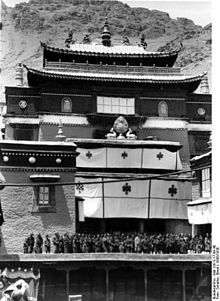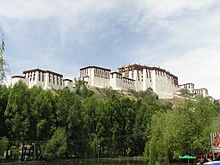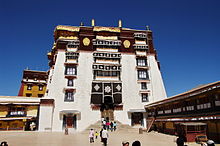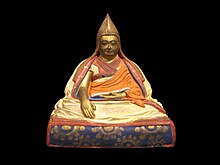
Dalai Lama is part of the full title "Holiness Knowing Everying Vajradhara Dalai Lama" given by Altan Khan, the first Shunyi King of Ming China. He offered it in appreciation to the leader of the Gelug school of Tibetan Buddhism, Sonam Gyatso, who received it in 1578 at Yanghua Monastery. At that time, Sonam Gyatso had just given teachings to the Khan, and so the title of Dalai Lama was also given to the entire tulku lineage. Sonam Gyatso became the 3rd Dalai Lama, while the first two tulkus in the lineage, the 1st Dalai Lama and the 2nd Dalai Lama, were posthumously awarded the title.

The Gelug is the newest of the four major schools of Tibetan Buddhism. It was founded by Je Tsongkhapa (1357–1419), a Tibetan philosopher, tantric yogi and lama and further expanded and developed by his disciples.

The Panchen Lama is a tulku of the Gelug school of Tibetan Buddhism. The Panchen Lama is one of the most important figures in the Gelug tradition, with its spiritual authority second only to the Dalai Lama. Along with the council of high lamas, he is in charge of seeking out the next Dalai Lama. Panchen is a portmanteau of Pandita and Chenpo, meaning "great scholar".

The Jonang is a school of Indo-Tibetan Buddhism. Its origins in Tibet can be traced to the early 12th century master Yumo Mikyo Dorje. It became widely known through the work of the popular 14th century figure Dolpopa Sherab Gyaltsen. The Jonang school's main practice is the Kālacakra tantra, and they are widely known for their defense of the philosophy known as shentong.
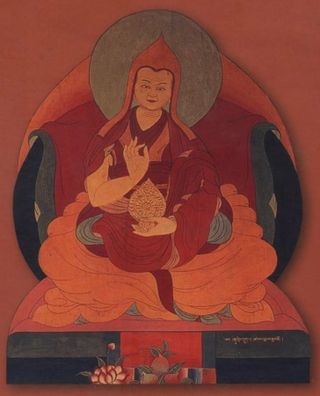
The 6th Dalai Lama, Tsangyang Gyatso, was recognized as the 6th Dalai Lama after a delay of many years, permitting the Potala Palace to be completed. He was an unconventional Dalai Lama that preferred a Nyingma school yogi's life to that of an ordained monk. He was later kidnapped and deposed by the Koshut Lha-bzang Khan.
The Dorje Shugden controversy is a controversy over Dorje Shugden, also known as Dolgyal, whom some consider to be one of several protectors of the Gelug school, the school of Tibetan Buddhism to which the Dalai Lamas belong. Dorje Shugden has become the symbolic focal point of a conflict over the "purity" of the Gelug school and the inclusion of non-Gelug teachings, especially Nyingma ones.

Güshi Khan was a Khoshut prince and founder of the Khoshut Khanate, who supplanted the Tumed descendants of Altan Khan as the main benefactor of the Dalai Lama and the Gelug school of Tibetan Buddhism. In 1637, Güshi Khan defeated a rival Mongol prince Choghtu Khong Tayiji, a Kagyu follower, near Qinghai Lake and established his khanate in Tibet over the next years. His military assistance to the Gelug school enabled the 5th Dalai Lama to establish political control over Tibet.

Desi Sangye Gyatso (1653–1705) was the sixth regent (desi) of the 5th Dalai Lama (1617–1682) in the Ganden Phodrang government. He founded the School of Medicine and Astrology called Men-Tsee-Khang on Chagpori in 1694 and wrote the Blue Beryl treatise. His name is sometimes written as Sangye Gyamtso and Sans-rGyas rGya-mTsho

Trülku Drakpa Gyeltsen (1619–1656) was an important Gelugpa lama and a contemporary of the 5th Dalai Lama (1617–1682). His Seat was the upper residence of Drepung Monastery, a famous Gelug gompa located near Lhasa.

Rinpungpa was a Tibetan dynastic regime that dominated much of Western Tibet between 1435 and 1565. During one period around 1500 the Rinpungpa lords came close to assembling the Tibetan lands around the Yarlung Tsangpo River under one authority, but their powers receded after 1512.

Tsangpa was a dynasty that dominated large parts of Tibet from 1565 to 1642. It was the last Tibetan royal dynasty to rule in their own name. The regime was founded by Karma Tseten, a low-born retainer of the prince of the Rinpungpa dynasty and governor of Samdrubtsé in Tsang since 1548.

Drongtse Monastery is a Tibetan Buddhist monastery was formerly one of the most important Gelug monasteries in Tsang, Tibet. There was also a chorten there.

Sönam Rapten, initially known as Gyalé Chödze and later on as Sönam Chöpel, was born in the Tholung valley in the Central Tibetan province of Ü. He started off as a monk-administrator of the Ganden Phodrang, the early Dalai Lamas' residence at Drepung Monastery, outside Lhasa, Tibet. From around or before the age of 20 he became the Treasurer and the "Chagdzo" of the Fourth (1589-1617) and, subsequently, the Fifth Dalai Lama (1617-1682). He presided as the most senior official of the Gelugpa school of Tibetan Buddhism for over 40 years.
Mipham Sonam Wangchuk Drakpa Namgyal Palzang was a king in Central Tibet. He belonged to the Phagmodrupa dynasty which reigned in Tibet, or parts of it, from 1354 to the early 17th century, and was the last prince of the dynasty.
Panchen Sonam Dragpa (1478–1554) was the fifteenth Ganden Tripa or throneholder of Ganden Monastery. His texts form the core curriculum for the Loseling College of Drepung Monastic University, the Shartse College of the Ganden Monastic University, and several other Gelugpa monasteries. He was taught by the second Dalai Lama and in turn later became the teacher of the third Dalai Lama.
Karma Phuntsok Namgyal was a king of Tibet who ruled from 1618 to 1620. He belonged to the Tsangpa dynasty that held power in Tsang since 1565 and was the foremost political and military power in Tibet until 1642.
Karma Tenkyong, in full Karma Tenkyong Wangpo, was a king of Tibet who ruled from 1620 to 1642. He belonged to the Tsangpa Dynasty which had been prominent in Tsang since 1565. His reign was marked by the increasingly bitter struggle against the Gelugpa sect and its leader the Dalai Lama. The outcome was the crushing of the Tsangpa regime and the establishment of the Dharma-based Tibetan state that endured until 1950.
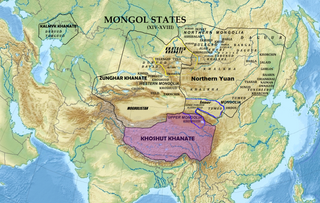
The Khoshut Khanate was a Mongol Oirat khanate based in the Tibetan Plateau from 1642 to 1717. Based in modern Qinghai, it was founded by Güshi Khan in 1642 after defeating the opponents of the Gelug school of Tibetan Buddhism in Tibet. The 5th Dalai Lama established a civil administration known as Ganden Phodrang with the aid of Güshi Khan. The role of the khanate in the affairs of Tibet has been subject to various interpretations. Some sources claim that the Khoshut did not interfere in Tibetan affairs and had a priest and patron relationship between the khan and Dalai Lama while others claim that Güshi appointed a minister, Sonam Rapten, as de facto administrator of civil affairs while the Dalai Lama was only responsible for religious matters. Güshi Khan accepted the nominal suzerainty of the Qing dynasty in 1654, when seal of authority and golden sheets were granted by the Shunzhi Emperor. In the last years of the khanate, Lha-bzang Khan murdered the Tibetan regent and deposed the 6th Dalai Lama in favor of a pretender Dalai Lama.
Kelden Gyatso (1607-1677) was a 17th-century Tibetan poet, scholar, and siddha. He was the first of the Rongwo Drubchen tulku lineage, and an important figure for Buddhism in Amdo, a region of north-eastern Tibet. The founder of a religious college and a seminary for tantric studies in Rebgong, throughout his life Kelden struggled between his desire to become a recluse hermit and his responsibility to these institutions. While he was ordained and taught in the Gelug school, he had a special affinity for Milarepa, the legendary Tibetan poet of the Kagyu school. The information that survives about Kelden comes from a biography by Jangchup Mila Ngawang Sönam (1636-1716), and from his poetry and songs, both written down and performed today by monks in Amdo.


